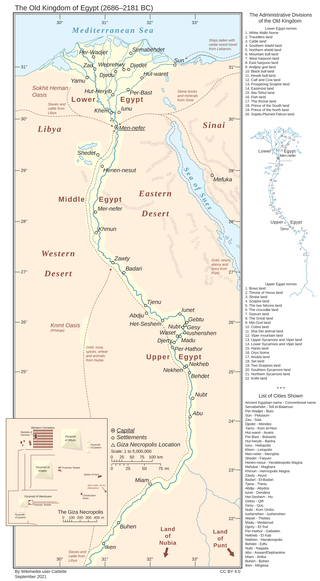
In ancient Egyptian history, the Old Kingdom is the period spanning c. 2700–2200 BC. It is also known as the "Age of the Pyramids" or the "Age of the Pyramid Builders", as it encompasses the reigns of the great pyramid-builders of the Fourth Dynasty, such as King Sneferu, who perfected the art of pyramid-building, and the kings Khufu, Khafre and Menkaure, who constructed the pyramids at Giza. Egypt attained its first sustained peak of civilization during the Old Kingdom, the first of three so-called "Kingdom" periods, which mark the high points of civilization in the lower Nile Valley.

The Great Sphinx of Giza is a limestone statue of a reclining sphinx, a mythical creature with the head of a human and the body of a lion. Facing directly from west to east, it stands on the Giza Plateau on the west bank of the Nile in Giza, Egypt. The face of the Sphinx appears to represent the pharaoh Khafre. The original shape of the Sphinx was cut from the bedrock, and has since been restored with layers of limestone blocks. It measures 73 m (240 ft) long from paw to tail, 20 m (66 ft) high from the base to the top of the head and 19 m (62 ft) wide at its rear haunches.
Pseudoarchaeology—also known as alternative archaeology, fringe archaeology, fantastic archaeology, cult archaeology, and spooky archaeology—is the interpretation of the past by people who are not professional archaeologists and who reject or ignore the accepted data gathering and analytical methods of the discipline. These pseudoscientific interpretations involve the use of artifacts, sites or materials to construct scientifically insubstantial theories to strengthen the pseudoarchaeologists' claims. Methods include exaggeration of evidence, dramatic or romanticized conclusions, use of fallacious arguments, and fabrication of evidence.

Graham Bruce Hancock is a British writer who promotes pseudoscientific theories involving ancient civilizations and hypothetical lost lands. Hancock speculates that an advanced ice age civilization was destroyed in a cataclysm, but that its survivors passed on their knowledge to hunter-gatherers, giving rise to the earliest known civilizations of ancient Egypt, Mesopotamia, and Mesoamerica.

Mu is a lost continent introduced by Augustus Le Plongeon (1825–1908), who identified the "Land of Mu" with Atlantis. The name was subsequently identified with the hypothetical land of Lemuria by James Churchward (1851–1936), who asserted that it was located in the Pacific Ocean before its destruction. The place of Mu in both pseudoscience and fantasy fiction is discussed in detail in Lost Continents by L. Sprague de Camp.

The Fourth Dynasty of ancient Egypt is characterized as a "golden age" of the Old Kingdom of Egypt. Dynasty IV lasted from c. 2613 to 2494 BC. It was a time of peace and prosperity as well as one during which trade with other countries is documented.

The Giza pyramid complex in Egypt is home to the Great Pyramid, the Pyramid of Khafre, and the Pyramid of Menkaure, along with their associated pyramid complexes and the Great Sphinx. All were built during the Fourth Dynasty of the Old Kingdom of ancient Egypt, between c. 2600 – c. 2500 BC. The site also includes several temples, cemeteries, and the remains of a workers' village.

Mark Lehner is an American archaeologist with more than 30 years of experience excavating in Egypt. He is the director of Ancient Egypt Research Associates (AERA) and has appeared in numerous tv documentaries.

Pyramidology refers to various religious or pseudoscientific speculations regarding pyramids, most often the Giza pyramid complex and the Great Pyramid of Giza in Egypt. Some "pyramidologists" also concern themselves with the monumental structures of pre-Columbian America, and the temples of Southeast Asia.
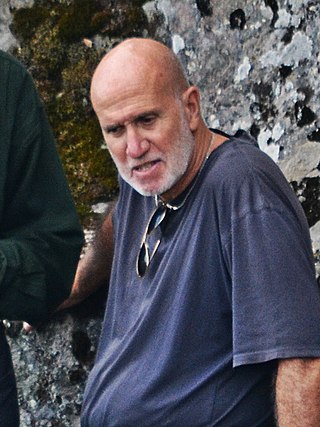
Robert Bauval is an Egyptian writer and lecturer, perhaps best known for the fringe Orion Correlation Theory regarding the Giza pyramid complex.
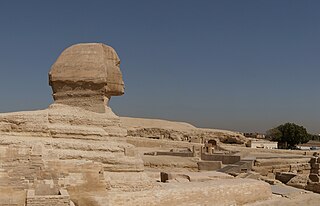
The Hall of Records is a purported ancient library that is claimed to exist underground near the Great Sphinx of Giza in Egypt. The concept originated with claims made by Edgar Cayce, an American who claimed to be clairvoyant and was a forerunner of the New Age movement. He said in the 1930s that refugees from Atlantis built the Hall of Records at Giza to preserve their knowledge. Cayce's assertions had many precursors, particularly the pseudohistorical theories about Atlantis that Ignatius Donnelly promulgated in the late 19th century, as well as claims about hidden passages at Giza that date back to medieval times.
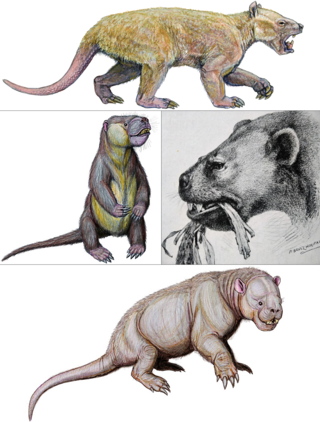
Taeniodonta is an extinct order of eutherian mammals, that lived in North America and Europe from the late Cretaceous (Maastrichtian) to middle Eocene.

The Yonaguni Monument, also known as "Yonaguni (Island) Submarine Ruins", is a submerged rock formation off the coast of Yonaguni, the southernmost of the Ryukyu Islands, in Japan. It lies approximately 100 kilometres east of Taiwan.

Selim Hassan was an Egyptian Egyptologist.
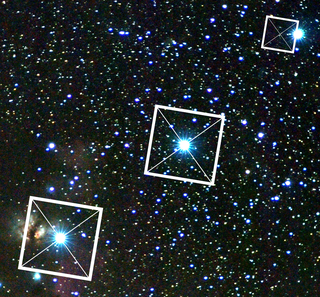
The Orion correlation theory is a fringe theory in Egyptology attempting to explain the arrangement of the Giza pyramid complex.

Ancient Aliens is an American television series produced by Prometheus Entertainment that explores the pseudoscientific hypothesis of ancient astronauts in a non-critical, documentary format. Episodes also explore related pseudoscientific and pseudohistoric topics, such as: Atlantis and other lost ancient civilizations, extraterrestrial contact and ufology, and popular conspiracy theories. The series, which has aired on History since 2010, has been a target for criticism of History's channel drift, as well as criticism for promoting unorthodox or unproven hypotheses as fact. According to Smithsonian, episodes of the series overwhelm the viewer with "fictions and distortions" by using a Gish gallop.

The Sphinx water erosion hypothesis is a fringe claim, contending that the Great Sphinx of Giza and its enclosing walls eroded primarily due to ancient floods or rainfalls, attributing their creation to Plato's lost civilization of Atlantis over 11,500 years ago.
John Anthony West was an American author and lecturer and a proponent of the Sphinx water erosion hypothesis. His early career was as a copywriter in Manhattan and science fiction writer. He received a Hugo Award Honorable Mention in 1962. After recovering from cancer, West died from pneumonia at the age of 85.
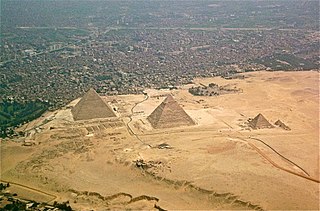
The Western Desert of Egypt is an area of the Sahara that lies west of the river Nile, up to the Libyan border, and south from the Mediterranean Sea to the border with Sudan. It is named in contrast to the Eastern Desert which extends east from the Nile to the Red Sea. The Western Desert is mostly rocky desert, though an area of sandy desert, known as the Great Sand Sea, lies to the west against the Libyan border. The desert covers an area of 680,650 km2 (262,800 sq mi) which is two-thirds of the land area of the country. Its highest elevation is 1,000 m (3,300 ft) in the Gilf Kebir plateau to the far south-west of the country, on the Egypt-Sudan-Libya border. The Western Desert is barren and uninhabited save for a chain of oases which extend in an arc from Siwa, in the north-west, to Kharga in the south. It has been the scene of conflict in modern times, particularly during the Second World War.
The Emerald Tablets of Thoth the Atlantean is a 1930 pseudohistorical book written by cult leader Maurice Doreal. Influenced by ancient Egyptian texts and Lovecraftian stories about part-reptilian civilizations emerging from ancient Egypt-like ruins, it deals with Atlantis, an ancient race of serpent-headed men, alchemy, and a variety of other topics.

















